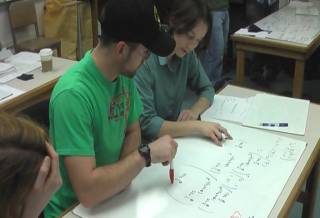You are here: start » activities » main
Analyzing the Probabilities of Time-Evolved States
Highlights of the activity
- Students are placed into small groups, given the worksheet corresponding to this activity, and asked to calculate the time dependence for several states.
- Students will see a process for time-evolving a quantum state.
- Groups will find that the probability of finding a quantum system in a particular state can vary with time.
Reasons to spend class time on the activity
- In introductory quantum mechanics, students typically only see quantum states that are independent of time. Because they have typically never seen time dependence in quantum states before, students will typically initially struggle with time-dependent states and determining if a probability calculation will be dependent on time.
- This activity gives students the opportunity to find how the state of a quantum system evolves with time. The class will also find that if the initial quantum state is an eigenstate of the Hamiltonian, then the probability of finding it in another state at some time t will be independent of time. It will also be shown that if any state is projected onto an eigenstate of the Hamiltonian when finding the probability of finding the particle in that eigenstate, the probability will be independent of time. Students will also find that time dependence in a probability calculation only occurs when the given quantum state that is not an eigenstate of the Hamiltonian and when that quantum state is projected onto something is not an eigenstate of the Hamiltonian either.
- Similar calculations to those given on the worksheet
 (add worksheet) can also be presented in matrix notation and with the most generic state
(add worksheet) can also be presented in matrix notation and with the most generic state
$$\vert \psi \rangle_{\hat{n}}= \left(\begin{array}{c} cos\left(\frac{\theta}{2}\right)\\ sin\left(\frac{\theta}{2}\right)e^{i\phi}\\ \end{array}\right) \; \; . $$
- Students will also explore time dependence in the expectation values due to time-dependent probabilities.
